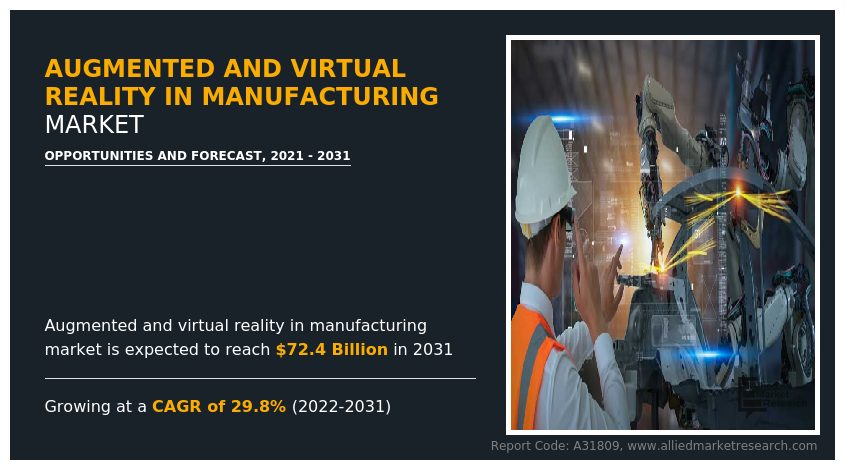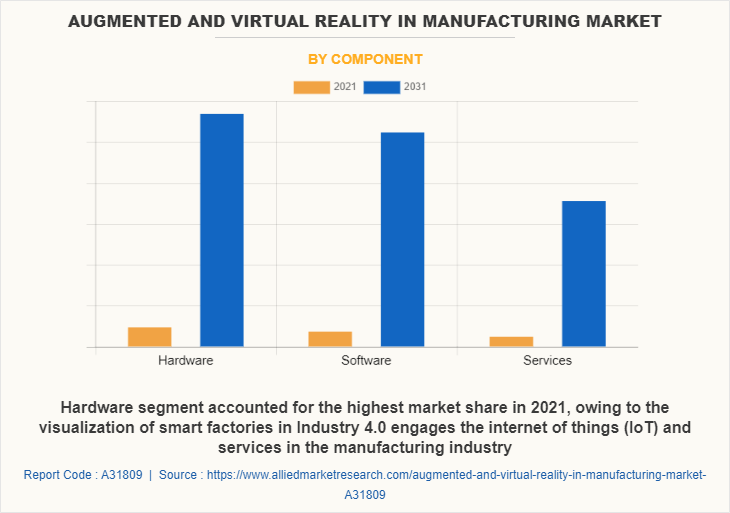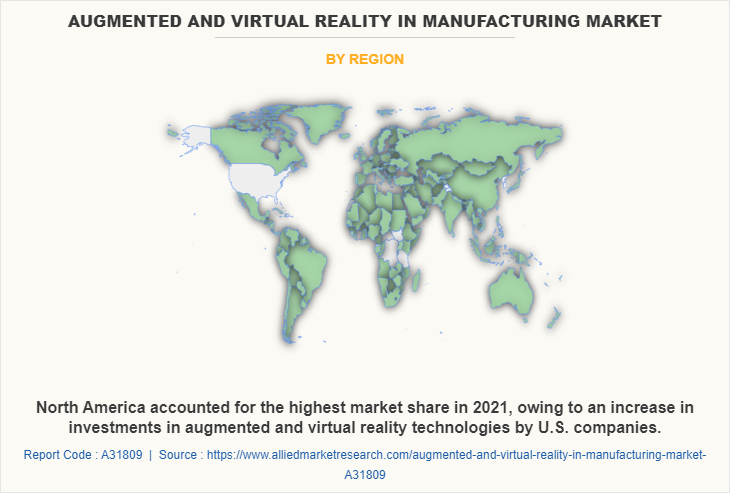Augmented and Virtual Reality in Manufacturing Market Statistics: 2031
The global augmented and virtual reality in manufacturing market size was valued at $5.4 billion in 2021, and is projected to reach $72.4 billion by 2031, growing at a CAGR of 29.8% from 2022 to 2031.
Rise in investments in AR and VR in manufacturing and increase in government initiatives for driving the adoption are driving the growth of the market. In addition, the cost-efficient benefits of augmented and virtual reality-based solutions in manufacturing are fueling the augmented and virtual reality in manufacturing market growth. However, the high investment required in setting up AR and VR in manufacturing market and concerns regarding security and privacy issues associated with AR limit the growth of this market. Conversely, the rise in digitalization in the manufacturing industry is anticipated to provide numerous opportunities for the expansion of AR and VR in manufacturing market during the forecast period.

The unprecedented demand for better hardware and software technologies is a crucial factor for the development of the market. The use of Augmented Reality (AR) and Virtual Reality (VR) technology is not restricted to a particular age group, and the heterogeneity of demand has given an impetus to market growth. A large number of people are inclined toward buying latest electronic gadgets. Further, increased affordability of the masses has created a farrago of opportunities within the augmented and virtual reality market, which is expected to be beneficial for market growth in the upcoming years.
The report focuses on growth prospects, restraints, and analysis of the global augmented and virtual reality in manufacturing market trends. The study provides Porter’s five forces analysis to understand the impact of various factors, such as bargaining power of suppliers, competitive intensity of competitors, the threat of new entrants, threat of substitutes, and bargaining power of buyers on the global augmented and virtual reality in manufacturing market share.
Top Impacting Factors
Rise in Investments on AR and VR in Manufacturing
Augmented reality & virtual reality technologies have gained acceptance due to technological advancements, which are encouraging established manufacturers to invest in technology upgradation. For instance, in June 2022, the augmented worker platform KIT-AR secured funding of about $1.99 million, which was led by Armilar Venture Partners and Caixa Capital Risc for its production line technology. KIT-AR (London) uses AR and artificial intelligence (AI) technology to help employees on a production line spot, track and minimize production errors. This factor is expected to boost the automotive, aerospace, and electronics manufacturing sectors, which eventually influence the proliferation of AR and VR technology.
In addition, the major investments due to the accessibility of numerous electronic items, such as tablets, and other smart devices, enabled interoperable features involving augmented reality and virtual reality technologies. Further, the rise in investments in AR/VR technology can impact businesses, ranging from internal industrial operations, to design, engineering, and field services, which can generate cost-saving and profitable returns on investments.
Moreover, the automotive, utility, and discrete manufacturing sectors are some of the major sectors that are early investors in the manufacturing sector, which further strengthens the adoption of AR/VR in the manufacturing market. Furthermore, with the growing adoption of hybrid work culture, where employees are distributed across the globe, the demand for virtual reality solutions as tools for immersive interactions become more accessible and affordable. This, in turn, will encourage companies to extend reality for team collaboration to incredible interactions with customers. This is also likely to have a significant role to improve the individual experience with the integration of other new disruptive ideas, such as the Metaverse. All these factors are expected to drive technology investments in the manufacturing industry, which eventually strengthen the market growth.
Increase in Government Initiatives for Driving the Adoption
In the era of emerging technologies, manufacturing sites should be well-designed, and several tasks can be handled using augmented reality to improve labor and employee safety. In addition, various developing nations are initiating significant initiatives and industry standards for driving AR and VR adoption across the world. For instance, National Electronics Policy, Proposed by MeitY, the policy helps to promote industry-led innovation in all sub-sectors of electronics and early-stage startups in emerging technologies including 5G, loT/ sensors, Artificial Intelligence (Al), Machine Learning, Virtual Reality (VR), drones, robotics, additive manufacturing, photonics, and nano-based devices.
In addition, the favorable initiatives to promote automation and innovation in the industry incorporate factors that lead to an increase in government initiatives. For instance, the IEEE Standards Association has developed several IT and BP standards in Europe, which aimed to the mission of which is to develop global standards related to digital reality, AR, VR, human augmentation, and related areas that are boosting augmented and virtual reality in manufacturing market growth.
Segment Review
The global augmented and virtual reality in manufacturing market analysis is segmented into component, technology, organization size, application, and region. Depending on the component, the market is divided into hardware, software, and services. By technology, it is divided into augmented reality and virtual reality. Based on organization size, it is categorized into large enterprises and small & medium-sized enterprises. Based on application, it is classified into product design and development, safety & training, and maintenance & repair. Region-wise, it is analyzed across North America, Europe, Asia-Pacific, and LAMEA.

Depending on the component, the hardware segment dominated the augmented and virtual reality in manufacturing industry share in 2022 and is expected to continue this trend during the forecast period, owing to the visualization of smart factories in Industry 4.0 engages the internet of things (IoT) and services in the manufacturing industry. However, the service segment is expected to witness the highest growth in the upcoming years, owing to the growing integration of the developing technologies of computer graphics, computer simulation, artificial intelligence, sensing, display, and network parallel to processing technologies in manufacturing is enhancing the services for manufacturing sectors.

Region wise, the augmented and virtual reality in manufacturing industry was dominated by North America in 2021 and is expected to retain its position during the forecast period, owing to the new advances in computerized modeling, visualization, simulation, and product data management are also making VR/AR a viable alternative to traditional product realization and manufacturing. However, Asia Pacific is expected to witness significant growth during the forecast period, owing to the supportive government initiatives in the manufacturing sector, an increase in adoption of AR and VR solutions for manufacturing, and advancement in internet connectivity.
The global augmented and virtual reality in manufacturing market is dominated by key players such as EON Reality, Inc., ESI Group, Google LLC, Kaon Interactive Inc., Microsoft Corporation, NOVAC Technology Solutions, Samsung Group, SkillReal, Vuzix Corporation, and Worldviz, Inc. These players have adopted various strategies to increase their market penetration and strengthen their position in the industry.
Digital Capabilities:
Augmented Reality (AR) and Virtual Reality (VR) are expected to be at the center of digital transformation and the spending of different companies, as a result, consumers are also drastically increased their adoption of virtualization solutions. In addition, the manufacturing industry is suffering from a growing labor shortage. AR technology can help to tackle this issue while building a workforce fit for the future, resulting in an increase in spending on virtual and augmented reality hardware is also evolving the AR and VR in manufacturing market growth. Personal and consumer services will lead to this growth through retail and discrete manufacturing.
In addition to technological development, the primary drivers for this growth will be the rapid growth in the adoption of tablets, computers, and smartphones, and the excessive concentration of major tech players in AR and VR worldwide in manufacturing. Furthermore, VR is a technology that is often regarded as a natural extension of 3D computer graphics with advanced input and output devices. Moreover, augmented reality is a technology that combines virtual information with the real world. This methodology uses a range of multimedia, 3D-Modelling, real-time tracking and registration, intelligent interaction, sensing, and others.
Moreover, a virtual reality (VR) System allows the user to experience an artificially created computer-generated environment like a real one. VR is a shared 3D experience between people and computers with certain unique capabilities that allow for a natural interaction of information between the two systems. As a result, VR is a way for humans to visualize, manipulate and interact with computers and extremely complex data. Visualization is possible through the capability of the computer to generate visual, auditory, or other.
End-User Adoption:
The global augmented and virtual reality in manufacturing market will witness faster growth due to an increase in the use of AR/VR for industrial operations, including, design, engineering, and field services. Furthermore, the is growing advancements in computational power, storage, graphics processing, and high-resolution displays have helped widened the use of AR/VR technologies in the fields of aerospace and defense, automotive, utility, and discrete manufacturing sectors, and others. Several large aerospace and defense companies leveraged AR to create a more flexible workforce. With AR, the company created guided work instructions in hours at a 10th of the cost, trained new workers 30 to 40% more efficiently, and reduced assembly time by half.
For instance, September 2022, AkzoNobel Aerospace Coatings launched a virtual reality training for painting aircraft, this technology can mimic a customer’s production environment and multiple coating systems to train teams virtually and in a more sustainable and efficient way.
In addition, a global manufacturer of business technology products, headquartered in the U.S., leveraged AR to connect field engineers with experts instead of providing service manuals and telephone support. First-time fix rates increased by 67% and the engineers’ efficiency increased by 20%. The average time to resolve problems dropped by more than 2 hours, thus, the decrease in the reaction time towards problem-solving.
Furthermore, manufacturing operation is enhanced by adoption 3D printing to produce rapid prototypes through the construction of layers from a digital blueprint, reducing labor time and material cost and increasing customization. Advanced planning and scheduling for assessing the real-time production and inventory data to minimize waste and cycle time are also pouring into the adoption of operational usage.
In addition, surge in the use of robotics to automatically perform a series of tasks at minimum cost with high accuracy, traditionally done by humans and now in collaboration with virtualization. Thus, virtual reality simulates manufacturing steps and helps to analyze market trends that drives the market growth.
Moreover, it also aids in warehouse operations by offering autonomous vehicles to carry and move materials and stock without a human being in control, which allows to increase transportation efficiency and reduces labor costs. Besides, intelligent sensors installed in warehouses help to track real-time movements and locations of raw materials, work-in-progress and finished products.
Additionally, sensors also protect employees against dangerous equipment operating close to them or monitor environmental conditions and other potential threats. The aforementioned factors can significantly improve the maintenance, health, and safety features, which in turn, are reinforcing AR and VR in manufacturing market growth among end-users.
Government Initiatives:
Governments of many countries support end-users to innovate new technologies such as augmented reality and virtual reality across a range of vertical, including manufacturing sector, owing to the growing adoption of augmented and virtual reality technology, which led to the formation of federal data privacy law protecting personal information, thus, resulted in the growth in the technologies that offer secure featured services.
Furthermore, growing concerns for privacy as VR and AR systems raise unique privacy concerns owing to their ability to capture huge amounts of data. This has introduced legislation to set federal data privacy and security standards that protect consumer data online. For instance, in October 2022, A federal data privacy law was set up to deliver critical safety guidance for the development and adoption of technologies similar to augmented and virtual reality.
Furthermore, the UK government is interested in virtual reality (VR) technology as new funding was announced to support innovations arising from the COVID-19 outbreak. In April 2020, an investment package of $1.22 billion to foster innovations across the UK businesses. This investment helps in the VR training platform enables medical students to upskill remotely and perform simulation surgeries.
Moreover, the Indian government is also taking initiatives to forester market innovation in augmented and virtual reality. For instance, in October 2022, The Department of Telecommunications (DoT) and Delhi Government had invited TechXR, a start-up, as the first presenter to showcase innovations and their use case in Education and Skill Development. This initiative has resulted in the availability of an affordable AR and VR solutions with a patented 6DoF AR-VR controller. Hence, all such developmental efforts and strategic initiatives are expected to create market growth opportunities.
Key Benefits for Stakeholders
The study provides an in-depth analysis of the global augmented and virtual reality in manufacturing market forecast along with current & future trends to explain the imminent investment pockets.
Information about key drivers, restraints, & opportunities and their impact analysis on global augmented and virtual reality in manufacturing trends is provided in the report.
Porter’s five forces analysis illustrates the potency of the buyers and suppliers operating in the industry.
The quantitative analysis of the augmented and virtual reality in manufacturing market from 2022 to 2031 is provided to determine the market potential.
Augmented and Virtual Reality in Manufacturing Market Report Highlights
| Aspects | Details |
| Market Size By 2031 | USD 72.4 billion |
| Growth Rate | CAGR of 29.8% |
| Forecast period | 2021 - 2031 |
| Report Pages | 223 |
| By Technology |
|
| By Component |
|
| By Organization Size |
|
| By Application |
|
| By Region |
|
| Key Market Players | NOVAC Technology Solutions, EON Reality, Inc., Microsoft Corporation, Worldviz, Inc., Kaon Interactive Inc., Vuzix Corporation, ESI Group, Samsung Group, SkillReal, Google LLC |
Analyst Review
In accordance with the insights by the CXOs of leading companies, the global augmented and virtual reality in manufacturing market is projected to witness prominent growth, especially in Asia-Pacific and Europe region. This growth is attributed to the high adoption of smartphone devices and increased awareness among the end-user industries regarding the benefits of augmented and virtual reality technology-based solutions. Prominent players operating in the augmented and virtual reality industry are inclined toward developing augmented and virtual content that can support various manufacturers in enhancing and augmenting existing product and service design and enabling entirely new techniques.
According to CXOs of key players operating in the augmented and virtual reality in manufacturing market, initial investments and development cost of training & simulation solutions among various end-user industries is higher as compared to other solutions. However, augmented and virtual technology-based solutions provide better options for training as compared to conventional tools and methods.
The solution manufacturers focus on very minute details of real incidents while developing the solutions, so that a user can get a real-world training with minimum wastage of resources such as money, human life, and physical entities. For instance, in November 2021, the Samsung Electronics innvested in DigiLens XR glasses firm at valuation over $500M. It raised for the development of its extended reality glasses (XR), which will offer AR features, such as overlaying digital images. This funding round puts the necessary pieces in place to finally bring enterprise and consumer smart glasses to market at a realistic price point.
Key players are projected to focus on the acquisition or strategic alliance with startups and well-established local players to expand their market presence and outperform competitors. For instance, in May 2022, Google acquired the startup firm, Raxium, which works on microLED display technologies for wearables and augmented and virtual reality (AR and VR) headsets. With the help of this acquisition Google continue to strengthen its AR/VR based product that will compete with other enterprises products.
The augment and virtual reality in manufacturing market is estimated to grow at a CAGR of 29.8% from 2022 to 2031.
The augment and virtual reality in manufacturing market is projected to reach $ 72,346.24 million by 2031.
Rise in investments in AR and VR in manufacturing, increase in government initiatives for driving the adoption, and cost-efficient benefits of augmented and virtual reality-based solutions in manufacturing.
The key players profiled in the report include EON Reality, Inc., ESI Group, Google LLC, Kaon Interactive Inc., Microsoft Corporation, NOVAC Technology Solutions, Samsung Group, SkillReal, Vuzix Corporation, and Worldviz, Inc.
The key growth strategies of augment and virtual reality in manufacturing market players include product portfolio expansion, mergers & acquisitions, agreements, geographical expansion, and collaborations.
Loading Table Of Content...



